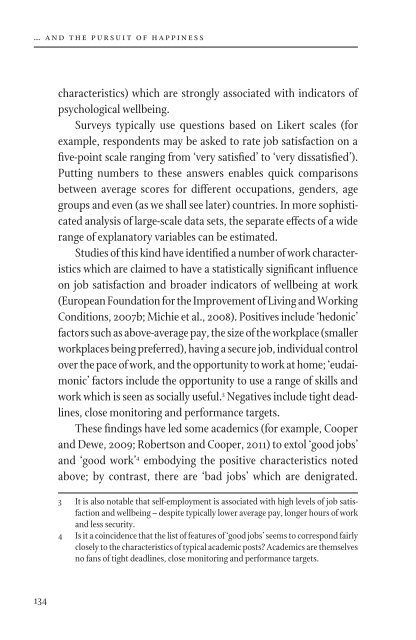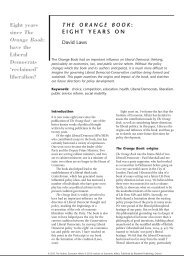… and the Pursuit of Happiness - Institute of Economic Affairs
… and the Pursuit of Happiness - Institute of Economic Affairs
… and the Pursuit of Happiness - Institute of Economic Affairs
You also want an ePaper? Increase the reach of your titles
YUMPU automatically turns print PDFs into web optimized ePapers that Google loves.
<strong>…</strong> <strong>and</strong> <strong>the</strong> pursuit <strong>of</strong> happiness<br />
wellbeing at work: any lessons?<br />
characteristics) which are strongly associated with indicators <strong>of</strong><br />
psychological wellbeing.<br />
Surveys typically use questions based on Likert scales (for<br />
example, respondents may be asked to rate job satisfaction on a<br />
five-point scale ranging from ‘very satisfied’ to ‘very dissatisfied’).<br />
Putting numbers to <strong>the</strong>se answers enables quick comparisons<br />
between average scores for different occupations, genders, age<br />
groups <strong>and</strong> even (as we shall see later) countries. In more sophisticated<br />
analysis <strong>of</strong> large-scale data sets, <strong>the</strong> separate effects <strong>of</strong> a wide<br />
range <strong>of</strong> explanatory variables can be estimated.<br />
Studies <strong>of</strong> this kind have identified a number <strong>of</strong> work characteristics<br />
which are claimed to have a statistically significant influence<br />
on job satisfaction <strong>and</strong> broader indicators <strong>of</strong> wellbeing at work<br />
(European Foundation for <strong>the</strong> Improvement <strong>of</strong> Living <strong>and</strong> Working<br />
Conditions, 2007b; Michie et al., 2008). Positives include ‘hedonic’<br />
factors such as above-average pay, <strong>the</strong> size <strong>of</strong> <strong>the</strong> workplace (smaller<br />
workplaces being preferred), having a secure job, individual control<br />
over <strong>the</strong> pace <strong>of</strong> work, <strong>and</strong> <strong>the</strong> opportunity to work at home; ‘eudaimonic’<br />
factors include <strong>the</strong> opportunity to use a range <strong>of</strong> skills <strong>and</strong><br />
work which is seen as socially useful. 3 Negatives include tight deadlines,<br />
close monitoring <strong>and</strong> performance targets.<br />
These findings have led some academics (for example, Cooper<br />
<strong>and</strong> Dewe, 2009; Robertson <strong>and</strong> Cooper, 2011) to extol ‘good jobs’<br />
<strong>and</strong> ‘good work’ 4 embodying <strong>the</strong> positive characteristics noted<br />
above; by contrast, <strong>the</strong>re are ‘bad jobs’ which are denigrated.<br />
3 It is also notable that self-employment is associated with high levels <strong>of</strong> job satisfaction<br />
<strong>and</strong> wellbeing – despite typically lower average pay, longer hours <strong>of</strong> work<br />
<strong>and</strong> less security.<br />
4 Is it a coincidence that <strong>the</strong> list <strong>of</strong> features <strong>of</strong> ‘good jobs’ seems to correspond fairly<br />
closely to <strong>the</strong> characteristics <strong>of</strong> typical academic posts? Academics are <strong>the</strong>mselves<br />
no fans <strong>of</strong> tight deadlines, close monitoring <strong>and</strong> performance targets.<br />
These poor-quality jobs are claimed to create stress (see Box<br />
overleaf) <strong>and</strong> may damage physical <strong>and</strong>/or mental health.<br />
Research also shows, however, that after controlling for workplace<br />
characteristics, <strong>the</strong>re are differences in job satisfaction <strong>and</strong><br />
wellbeing which are associated with personal characteristics.<br />
Most obviously, in <strong>the</strong> UK at least, women consistently show<br />
higher levels <strong>of</strong> job satisfaction than men. Their preferences are<br />
also different: working in <strong>the</strong> public sector adding to job satisfaction<br />
for women, but not for men, for example. Ethnicity is a<br />
factor, with black employees less satisfied than white employees.<br />
Age is also relevant, with younger workers less satisfied than older<br />
ones (though <strong>the</strong> relationship is not straightforward). Graduates<br />
are less happy than non-graduates. Non-unionised workers<br />
appear to be happier than unionised workers. Place in <strong>the</strong> job<br />
hierarchy is also a factor, with managers more satisfied than o<strong>the</strong>r<br />
workers. 5<br />
In addition to <strong>the</strong>se broad categories, it is also <strong>the</strong> case that<br />
people differ in <strong>the</strong>ir psychological wellbeing at work as a result<br />
5 This mixture <strong>of</strong> workplace <strong>and</strong> personal characteristics as determinants <strong>of</strong> subjective<br />
job satisfaction has a counterpart in explanations <strong>of</strong> more objective indicators<br />
such as turnover rates <strong>and</strong> sickness absences – which may be considered as<br />
manifestations <strong>of</strong> dissatisfaction with jobs. Low turnover is associated with high<br />
relative pay, unionisation <strong>and</strong> <strong>the</strong> availability <strong>of</strong> training among workplace characteristics.<br />
At a personal level, men are more likely to quit for better-paid jobs<br />
than women, while higher-grade staff are more likely to move than lower-grade<br />
employees. As for sickness absence, analysis <strong>of</strong> UK Labour Force Survey data<br />
(Leaker, 2008) shows that, controlling for o<strong>the</strong>r factors, employees in workplaces<br />
with more than 500 employees are 34 per cent more likely to be absent than those<br />
in workplaces with fewer than 25 employees. Those working in <strong>the</strong> public sector<br />
are 22 per cent more likely to take sickness leave than those in <strong>the</strong> private sector.<br />
But personal characteristics – gender, ethnicity <strong>and</strong> age –have a significant<br />
impact as well. For instance, perhaps surprisingly, employees aged 16 to 24 are 32<br />
per cent more likely to be absent than those aged 50 to 59 (women)/64 (men).<br />
134 135












